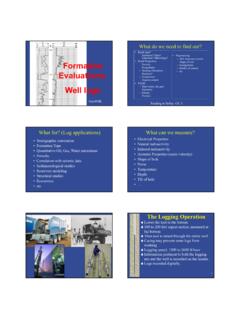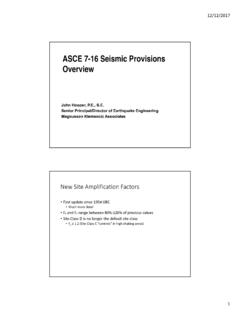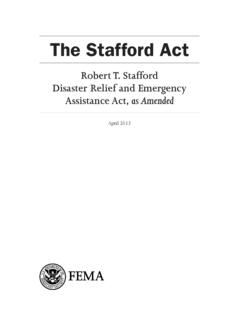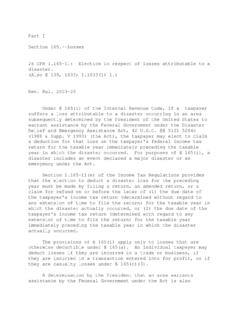Transcription of Structural Geology: Deformation of Rocks
1 Structural geology : Deformation of RocksGeology 200 geology for Environmental ScientistsMajor Concepts Foldsin Rocks range from microscopic to hundreds of kilometers across. Faultsare fractures along which displacement has occurred. Jointsare fractures where there has been no displacement. Rocks deform when applied stress exceeds rock strength. Deformation may be ductileflow or anticlines and synclines-plunge out eventually, don t go on forever domes and basins-very broad features within continental interiors complex folds-the result of very ductile behaviorFig. Types of foldsFig. A series of anticlines & synclines in southern CaliforniaAnticline-syncline fold pair in SW WalesFaults: 3 major categories normal faults-caused by extension or tension thrust faults and reverse faults-caused by compression strike-slip or tear faults-caused by lateral shearNormal faultThrust faultStrike-slip faultIn both normal and reverse faults the hanging wall is above the footwall.
2 Miners following mineral veins would walk down the footwall and hang their lanterns on the hanging and Dip Describes the orientations of bedding planes, faults, or joints. Strike -compass bearing of a horizontal line on a plane Dip -the inclination of a plane from the horizontal. Dip direction is always at a right angle to the strike. See Fig. in your & DipA graphic representation of the concept of strike and dip of bedded of strikes and dips for a Nomenclature anticlines - Rocks older in the center synclines - Rocks younger in the center limbs hinge and hinge plane or axial plane plungeFig. Fold geometryExamples of horizontal and plunging fold Fold at geology Field Camp in SDOrogenic belt with complex foldingFig. A plunging anticline in southern UtahPlunging anticline, MontanaPlunging anticline, MontanaAnticline in the Keefer Sandstone of WVOpen fold in the Tuscarora Sandstone, WVU geology Field CampOverturned folds: anticline-syncline pair in the core of an ancient mountain system, South Georgia IslandIsoclinal folds along the coast of MaineIsoclinal folds along the coast of MaineChevron folds in brittle Rocks .
3 An example of angle parallel parallel or kink folds in ItalyDomes and Basins Very large features with gentle dips, usually only visible on geologic maps (too large to recognize on the ground). Restricted to continental interiors. Examples include the Michigan Basin, Illinois Basin, Cincinnati Arch, Nashville Dome, Black Hills, Black Hills of South Dakota are a Structural Map of the Black Hills of South DakotaFig. A small dome in TexasMichigan BasinGeologic Map of Michigan BasinComplex Folds Formed by intense Deformation in mountain ranges. Usually the result of multiple episodes of folding. The folds themselves may be folded and they are often recumbent. Can be at any scale from outcrop to map folds in sandstone, Cornwall, UKRecumbent isoclinal folds in meta-sediments, ScotlandComplex folding in Ga meta-sediments, Adirondack Mtns. of New YorkComplex, disharmonic folds in ductile folds of migmatitein metamorphic Rocks , SpainFig.
4 Major types of faultsFig. Easily recognized displacementFig. Easily recognized displacementNormal faultsExtension experiment in tectonic modeling lab exerciseExtension experiment in tectonic modeling lab exerciseThe Mid-Atlantic Ridge in Iceland. Note the fault scarps and tilted fault blocks caused by Normal faults produce grabens & horstsSmall scale listric normal faulting caused by gravity sliding. The faults becomes horizontal at depth. Can you recognize the fault planes?Small scale faulting in soft sediments, both normal and reversed. Notice the horsts and faultingTypes of Thrust Faults Fault bend folds-fault forms before the fold; Deformation restricted to the hanging wall Fault propagation folds-fault forms along with the folding; Deformation in both the hanging wall and foot wallExample of a fault-bend fold thrust fault at the WVU geology Field Camp. Cross-sections fromThorbjornsenand Dunne, propagation folds, backthrusts, and pop-up structure.
5 Yukon River near Eagle, directionCompression experiment in tectonic modeling lab exerciseCompression experiment in tectonic modeling lab exerciseThrust faults seen on a seismic line across an oil faulting: a fault propagation soil layer along a lake in Wisconsin caused by thrusting of ice on shore by high winds during spring thaw. Note the formation of the fault propagation fold and the anticline core exposed in the background by a tear fault in the Grand Canyon. Precambrian Rocks on the left, Paleozoic Rocks on the right. What type of fault is this?Fault scarp along the coast of Wales. What is the direction of motion? What type of fault is this?Fault scarp in the California desert. What is the direction of motion? What type of fault is this?Strike-slip fault, San Andreas Fault, CaliforniaFig. Strike-slip faults offset drainage, San Andreas Fault, CaliforniaAugust 17, 1999 earthquake in Turkey.
6 On the Richter scale. The fault is a strike-slip fault between the Arabian and European plates. August 17, 1999 earthquake in Turkey --rapid, brittle deformationAugust 17, 1999 earthquake in Turkey --rapid, brittle deformationJoints Fractures in Rocks with no appreciable displacement. They are very common in all Rocks . Such joints are often zones of weakness where later faults could develop. Fluids can travel along joints: water, petroleum, pollution valuable metal ores may form along joints from hydrothermal s Tower, WyomingColumnar joints in volcanic rockExfoliation: horizontal joints formed by sheeting as overburden pressure is of Rock Deformation Stress -pressure placed on Rocks Strain - Deformation of the rock Strength -rock resistance to Deformation Brittle Deformation -the Rocks break or fracture. Occurs at low temperatures and low pressures. Ductile Deformation -the Rocks bend or flow.
7 Occurs at higher temperature and of a rock cylinder: left -uncompressed; center -confined pressure, ductile Deformation ; right -unconfined pressure, brittle deformationFigure Brittle vs. ductile behavior of rockStrain indicators fault offset tension gashes fractures ductile flowRight-lateral displacement along strike-slip fault, Hayward, CA. Curb underwent brittle rupture whereas asphalt failed by a series of en echelon tension gashes in limestone filled with calcite. Motion is left lateral. Gashes are echelon sigmoidal veins in a brittle-ductile shear zone. Motion is right lateral. Gashes are control on Deformation . The dolostone shows brittle Deformation whereas the surrounding limestone was ductilely of bed thickness on ductile flow. Thicker bed of limestone folded, whereas thin beds were squeezed out of the fold cores (curved nonparallel folding).Boudinage in a granitic sill intruded into schist.
8 An example of ductile flow.







